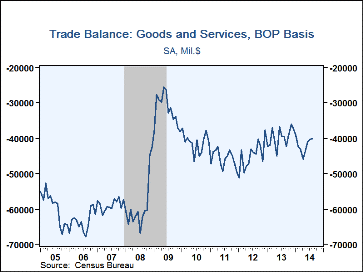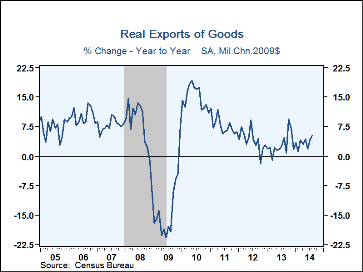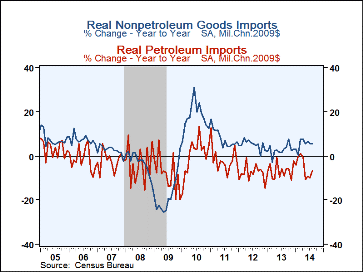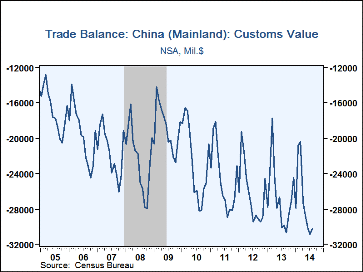 Global| Oct 03 2014
Global| Oct 03 2014U.S. Trade Deficit Steady in August
Summary
The U.S. foreign trade deficit in goods and services narrowed marginally in August to $40.1 billion from $40.3 billion in July. That month had edged in from $40.8 billion in June. The Action Economics consensus expectation looked for [...]
The U.S. foreign trade deficit in goods and services narrowed marginally in August to $40.1 billion from $40.3 billion in July. That month had edged in from $40.8 billion in June. The Action Economics consensus expectation looked for a modest widening in the August figure to $40.8 billion from an initially reported $40.5 billion in July. The August deficit resulted from a 0.2% rise in exports (4.1% y/y) and a 0.1% uptick in imports (3.7% y/y).
The overall trade deficit in goods was $59.9 billion, also close to the prior couple of months, $59.8 billion in July and $60.4 billion in June. The balance on services was a surplus of $19.8 billion in August, following $19.5 billion in July and $19.6 billion in June. Exports of services were $59.6 billion in August, up slightly from $59.3 billion in July and up 3.2% from August 2013.. Services imports were $39.9 billion in August, up from $39.8 billion in July and 2.8% higher than the year earlier.
In real terms, the deficit in goods was $47.9 billion in August, a bit wider than July's $47.8 billion. Exports in chained 2009 dollars rose 1.0% (5.2% y/y), following a 1.4% increase in July. Industrial materials and supplies gained 2.7% after a 2.3% rise in July. Capital goods were also firm, with an August increase of 2.1% after 1.2% in July. Automotive exports had jumped in July by 12.1%, and then fell back by 11.0% in August. Nonauto consumer goods had the reverse of that pattern, falling 4.4% in July and increasing 4.5% in August. Real foods, feeds & beverages exports have been sluggish all year long; they fell 4.9% in July and another 2.5% in August.
On the import side, the total in chained 2009 dollars was up 0.8% in August (3.8% y/y). Nonpetroleum imports were up 0.6% in the month, 5.8% year-on-year. Inflation-adjusted industrial materials and supplies rose 2.4% in August, capital goods 3.5%, and nonauto consumer goods 1.5%. Countering these increases were declines in food, feeds and beverages of 3.7%, automotive of 4.7% and "other" of 7.1%. Petroleum imports rose 1.6% in both July and August after two successive declines greater than 5%; the August amount was 6.7% below August 2013. The volume of crude oil imported was 6.947 million barrels per day, and the average price was $96.32, down from July but about the same as in May and June.
By region, the August trade deficit with China was $30.2 billion, slightly narrower than July's $30.9 billion; exports there were up 3.7% in the month and 3.0% from a year ago, while imports fell 0.8% month-on-month and were up just 1.7% year-on-year. Trade with Japan showed a smaller deficit, $4.7 billion after $6.2 billion in July; exports were up 16.2% (11.8% y/y) and imports fell 5.1% (-7.9% y/y). The trade deficit with the Euro Area diminished in August to $10.1 billion from $11.5 billion in July; exports to those European nations rose 3.0% in the month (4.6% y/y) and imports fell 3.1% (+13.0% y/y). The regional data are in current dollars and are not seasonally adjusted.
The international trade data can be found in Haver's USECON database. Detailed figures are available in the USINT database. The expectations figures are from the Action Economics Forecast Survey, which is carried in the AS1REPNA.
| Foreign Trade (Current Dollars) | Aug | Jul | Jun | Y/Y | 2013 | 2012 | 2011 |
|---|---|---|---|---|---|---|---|
| U.S. Trade Deficit | $40.1 bil. | $40.3 bil. | $40.8 bil. | $36.6 bil. (8/13) |
$476.4 bil. | $537.6 bil. | $548.6 bil. |
| Exports (%) | 0.2 | 0.9 | 0.0 | 2.9 | 2.9 | 4.2 | 14.8 |
| Imports | 0.1 | 0.6 | 1.1 | 4.6 | 0.1 | 2.9 | 13.9 |
| Petroleum | -3.8 | 3.4 | -3.3 | -6.9 | -11.0 | -5.5 | 30.7 |
| Nonpetroleum goods | 0.7 | 0.2 | -1.1 | 6.9 | 2.0 | 5.2 | 12.1 |
Carol Stone, CBE
AuthorMore in Author Profile »Carol Stone, CBE came to Haver Analytics in 2003 following more than 35 years as a financial market economist at major Wall Street financial institutions, most especially Merrill Lynch and Nomura Securities. She has broad experience in analysis and forecasting of flow-of-funds accounts, the federal budget and Federal Reserve operations. At Nomura Securites, among other duties, she developed various indicator forecasting tools and edited a daily global publication produced in London and New York for readers in Tokyo. At Haver Analytics, Carol is a member of the Research Department, aiding database managers with research and documentation efforts, as well as posting commentary on select economic reports. In addition, she conducts Ways-of-the-World, a blog on economic issues for an Episcopal-Church-affiliated website, The Geranium Farm. During her career, Carol served as an officer of the Money Marketeers and the Downtown Economists Club. She has a PhD from NYU's Stern School of Business. She lives in Brooklyn, New York, and has a weekend home on Long Island.









